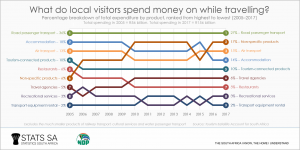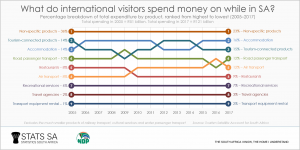How do tourists spend their money?
Fancy a meal out, or would you rather save up for accommodation when on holiday? We take a peek into the spending habits of domestic and international visitors who criss-cross the South African landscape.
Visitors1 spent just over half a million rand every minute during the course of 2017! That amounts to R277 billion for the entire year, according to the latest Tourism Satellite Account for South Africa report.2 Domestic visitors were the biggest spenders, pumping R156 billion (or 56%)3 into the economy, while international visitors contributed the remaining R121 billion (or 44%).4
A little digging into domestic visitor expenditure reveals that local explorers focused their spending on road passenger transportation (taking up 27% of the R156 billion), followed by non-specific products. These are products that visitors buy that are not specifically related to tourism-characteristic activities. Retail (‘shopping’) products fall into this category.
Air transport was ranked as the 3rd most important item in the domestic visitor’s budget, contributing 15% to total spending in 2017 (click on the image to enlarge).
The beautiful thing about this analysis is that annual data are available from as far back as 2005, showing how domestic visitors have shifted their habits over time. Road passenger transportation was also ranked #1 in 2005, but this item took up 36% of total domestic expenditure then, higher than the 27% recorded in 2017. Accommodation was the second-most important item in 2005, falling to 4th place in 2017.
The major mover, however, was non-specific products, shifting from 6th place in 2005 to 2nd spot in 2017.
Non-resident visitors gracing our shores have slightly different spending priorities. The major spending item for international visitors is non-specific products, followed by accommodation and tourism-connected products.5 Road passenger transportation was the fourth-most important expenditure item.
The spending habits of international visitors have remained more stable over time, with little change happening from 2005 to 2017.
So next time you pack the car or board a plane to go exploring our country on holiday, take pride in the fact that you are making an important contribution to our economy.
1A visitor is a traveller who takes a trip to a place outside their usual environment, for less than a year, for any purpose other than to be employed at the place visited. A visitor can either be a same-day visitor, who visits a place for less than one night, or a tourist, whose trip includes an overnight stay.
2 Stats SA, Tourism Satellite Account for South Africa, final 2015 and provisional 2016 and 2017, Table 9 (view here).
3 Stats SA, Tourism Satellite Account for South Africa, final 2015 and provisional 2016 and 2017, Table 7 and Table 8 (view here).
4 Stats SA, Tourism Satellite Account for South Africa, final 2015 and provisional 2016 and 2017, Table 5 and Table 6 (view here).
5 A tourism-connected (or related) product is distinct from a tourism-characteristic product in that visitors consume a smaller proportion of the total supply of the product. For a product to be classified as a tourism-connected product, visitors must purchase more than 0 per cent and less than 25 per cent of its production. A tourism-characteristic product, on the other hand, is a product that will cease to exist in meaningful quantity, or for which the level of consumption would be significantly reduced, in the absence of visitors.
Similar articles are available on the Stats SA website and can be accessed here.
For a monthly overview of economic indicators and infographics, catch the latest edition of the Stats Biz newsletter here.



